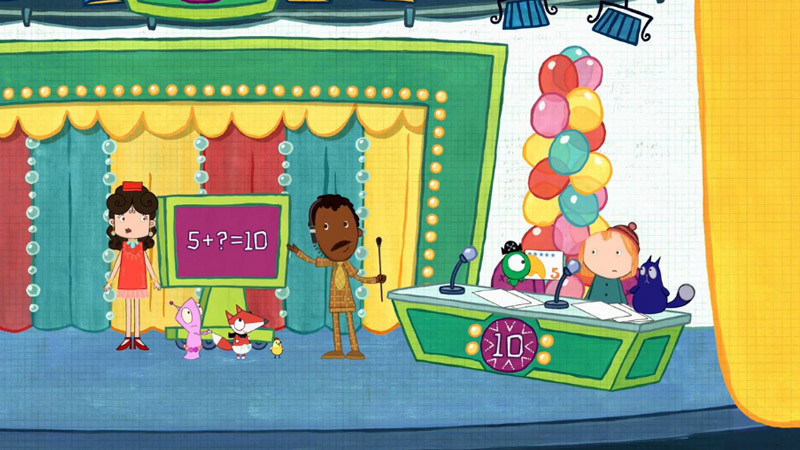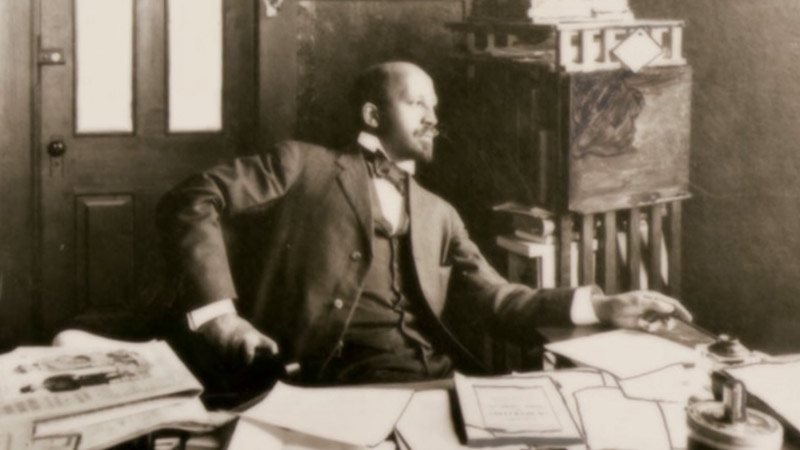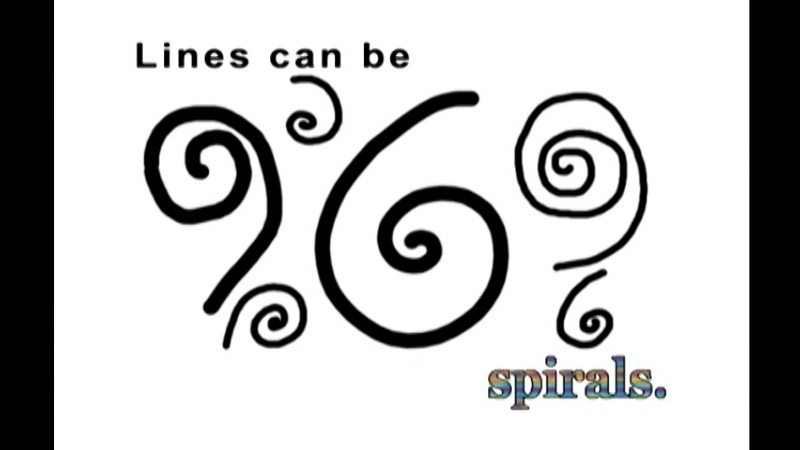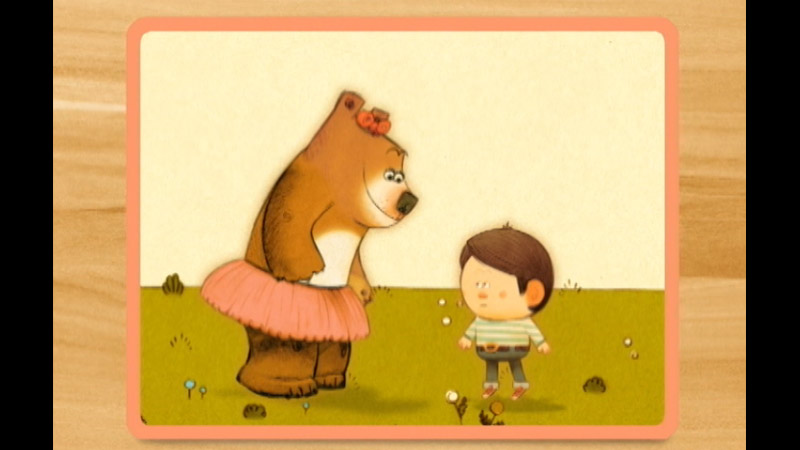
Welcome to the Description Key
Description is the key to opening a world of information for persons with a vision loss, literacy needs, or loss of cognitive abilities. The American Foundation for the Blind reports that 21.5 million adults have vision loss and 94,000 children with a vision loss are being helped by some kind of special education. While description was developed for people who are blind or visually impaired, sighted children may also benefit from description’s concise, objective translation of media’s key visual components. Specialized learners, such as students with learning differences, English language learners, and children on the autism spectrum, benefit from its value in literacy development (e.g., vocabulary and reading) and content learning. DCMP’s Listening Is Learning campaign focuses on these benefits.
These guidelines are a key for those performing description, and cover a range of topics from preparing to describe to determining both what information needs to be described and how to describe it. The information is also applicable to vendors and other businesses that provide description for broadcast television, movies, and other media. Thus, it will also be useful to media producers/distributors and others who are considering describing their products or learning about description. Some background information and rationale are included for the novice, as well as an evolving list of description resources to help improve the quality and efficiency of one’s description.
For those interested in a condensed version of these guidelines, a “Description Tip Sheet” is available from the DCMP Learning Center. In addition, this YouTube video from a Video Description Research and Development Center (VDRDC) webinar presented in October, 2012 summarizes important considerations.
A Definition of Description
Description is the verbal depiction of key visual elements in media and live productions. Also known as "audio description" or "video description," the description of media involves the interspersion of these depictions with the program's original audio.
The vocabulary and language structure used in the description of educational media should be consistent with that used in the program being described. It is also important to make a distinction between media that is produced for educational purposes and that which is produced purely for entertainment—the "key visual elements" of an educational program should be those that serve in conveying a specific learning goal.
DCMP Description Philosophy
It is vital that media be described in such a manner that an individual program's educational content is accessible to students with a wide range of visual impairments. It is important to ensure that description does not distract viewers from the educational content of a production by being overly complex or, on the other hand, overly simplistic. It's been long said that "pictures are worth a thousand words," and it's in choosing which of those words best convey otherwise inaccessible images to students with vision loss that the true skill of a describer is practiced.
Description Key - About the Key
About the Description Key
Originally developed through a partnership between the Described and Captioned Media Program (DCMP) and the American Foundation for the Blind (AFB), the Description Key began as recommendations, suggestions, and best practices culled from an extensive literature search and meta-analysis [PDF] in 2006.
An expert panel in media description and education for children with visual impairments was assembled to help evaluate media description strategies for educational material. Panel members included: DCMP staff, Annemarie Cooke (DeWitt and Associates), David Dawson (Audio Information Network of Colorado), Joy R. Efron, Kay Alicyn Ferrell (University of Northern Colorado), Megan Finnerty (University of Northern Colorado), Jeremy M. Fisher (CaptionMax), Bryan Gould (WGBH), Laurel J. Hudson (Teacher/Professor), Terry Maggiore (Teacher/Parent), Betsy L. McGinnity (Perkins School for the Blind), Cyral Miller (Texas School for the Blind and Visually Impaired), Martin Monson (University of Northern Colorado), Mary Ann Siller (American Foundation for the Blind), Joel Snyder (Audio Description Associates), and Dean O. Stenehjem (Washington State School for the Blind).
The list of recommended practices was then subjected to a consensus review process by these leading experts, resulting in a reduction from 204 to 63 critical indicators. This work was opened to an extensive public review in the spring of 2008 that invited comments and rankings of each indicator's importance. The expert panel met a final time in July 2008 to review these public comments, the rankings, and to discuss each indicator before adopting the final document presented here. (For a more detailed look at how (and why) the Key was developed, please read "Background of the Description Key.")
Since 2008 some fine tuning and revision of guidelines has taken place based on: (a) DCMP experiences in working with a large number of vendors that provide description service; (b) input from a large number of professionals and consumers who have served on the DCMP board and acted as DCMP advisors; (c) recent (2011) partnerships with the American Council of the Blind (ACB) and with the Video Description Research and Development Center (VDRDC) as a member of the VDRDC Description Leadership Network.
About the Described and Captioned Media Program
The DCMP is a unique accessible media resource serving the United States and its territories. DCMP services include: (a) a library of free-loan described and captioned educational media for K-12, (b) a learning center of information on media access, and (c) guidelines for the creation of description and captioning.
Back to Top
Description Key - Background
- Background of the Description Key
- History of Description
- Describing for Children
- A Final Note
- References and Resources
Background of the Description Key
Adapted from the original "Background of The Description Key," written in 2008 by Kay Alicyn Ferrell and Mary Ann Siller, American Foundation for the Blind.
—Helen Keller, 1930
It has long been advocated that educational media should contain descriptions of visual content suitable for persons who are blind or visually impaired. This is particularly important in current day classrooms, which increasingly rely on multimedia instructional materials. These materials often present serious restrictions in terms of access to the general education curriculum.
Description is the verbal depiction of key visual elements in a television program, video, DVD, or other multimedia presentation. Inserted into natural pauses in the program's soundtrack, description provides information that otherwise would remain inaccessible to someone who is blind or visually impaired without the assistance of a sighted person. It is similar to captioning in that both are important tools for equal access to educational media for people with disabilities. While captioning has enjoyed almost five decades of development and successful implementation, video or media description is still relatively new to the educational environment.
The Description Key began as recommendations, suggestions, and best practices culled from an extensive literature search and meta-analysis [PDF] in 2006. An expert panel in media description and education for children with visual impairments was assembled to help evaluate media description strategies for educational material. The list of recommended practices was then subjected to a consensus review process by these leading experts, resulting in a reduction from 204 to 63 critical indicators. This work was opened to an extensive public review in the spring of 2008 that invited comments and rankings of each indicator's importance. The expert panel met a final time in July 2008 to review these public comments, the rankings, and to discuss each indicator before adopting the final document presented here.
History of Description
As far back as 1964, advocates for accessibility, such as Chet Avery, a U.S. Department of Education official, and, in the 1970s, Gregory Frazier, a professor and founder of AudioVision, envisioned the type of equal access that description could provide to people who are blind or visually impaired. Description also has roots in radio reading services for the blind, which began in Minnesota in 1969. Dr. Margaret Pfanstiehl, founder of The Metropolitan Washington Ear, the radio reading service of Washington, D.C., is credited with the invention of the first ongoing audio description service in 1981. Designed primarily for adults with visual impairment attending theater productions, audio description has expanded into other cultural venues as well. In the late 1980s, WGBH, Boston's public broadcasting station, received training from Dr. Pfanstiehl and, along with the Narrative Television Network, brought the description service to television audiences. In 1997 WGBH introduced description in movie theaters for regularly scheduled screenings. (For more on the history of description, read DCMP's Description Time Line Highlights [PDF].)
Description services are now routinely offered by several providers at movies, museums, and dance productions, as well as on television, to viewers with visual impairments. Known by several terms—"audio description," "video description," "descriptive video information," "Descriptive Video Service™" and "DVS™," "narrative description," and/or "descriptive video"—description is typically provided through a secondary audio channel or the Secondary Audio Programming (SAP) channel for analog television and ancillary audio services for DTV.
Description has great appeal to adults with visual impairments, many of whom have cited the following benefits: (a) increased knowledge about the visual world, (b) greater understanding of televised materials, (c) independence and elimination of reliance on sighted companion viewers, (d) social connection, (e) equality with sighted individuals, (f) enjoyment, and (g) greater comfort in discussing television programs with sighted acquaintances (Fels, Udo, Ting, & Diamond, 2006; Packer, 2005; Schmeidler & Kirchner, 2001). Audio description is used both for the enriching, aesthetic experience of the content of a production as well as for cultural inclusion (Ellis, 1991).
In 2000, the Federal Communications Commission (FCC) issued a rule requiring major television and cable networks in large markets to provide a minimum number of hours weekly of described television, noting that:
In 2002 shortly after the proposed rule took effect, it was struck down by the United States Court of Appeals, which found that the Telecommunications Act of 1996 did not authorize the FCC to adopt regulations requiring description of television content.
Many television networks, most notably PBS, CBS, TCM, and FOX offer some televised description, but several others have stopped providing description services in the absence of any federal requirement to do so. On December 21, 2007 the U.S. House of Representatives released a draft bill, the Twenty-First Century Communications and Video Accessibility Act, which authorizes the previous proposed regulations and expands them to digital television technologies. This Act awaits Congressional action.
As the use of digital media has increased exponentially in classrooms across America, their accessibility to students with visual impairment has remained elusive. Classrooms still rely on simultaneous human descriptions of real-time visual materials, even though the technology exists to make these educational materials accessible to students with visual impairment. The Office of Special Education Programs in the U.S. Department of Education took a giant step forward by awarding a cooperative agreement to NAD in 2006 (and subsequent renewal in 2011) for:
Description makes real the promise of the Individuals with Disabilities Education Act: The opportunity to help students with visual impairments attain the same access to today's curricular materials that their sighted classmates take for granted. DCMP is a milestone for the education of students with visual impairment.
Describing for Children
Description for adults with vision loss has more than 25 years of history and experience behind it. Unfortunately, there is little research to explain how description mediates cognitive structures developed through other sensory modalities or how best to script the description to construct effective and efficient representations that build a relevant conceptual model for either adults or children (Piety, 2003, 2004). The representation of visual information made possible by description is:
AFB believes that description for children is fundamentally different than description for adults, primarily because concept development is still in process. With adults, one can assume a certain level of exposure, whether it originates in literature or in other cultural experiences. The same cannot be said for children with vision loss, whose experiences are limited by the visual impairment and time itself. As Ferrell (1997) explained,
This different learning style has implications for educational description, because it affects how children with vision loss obtain information, form concepts, and categorize those concepts for later use. For example, children with visual impairment generally share the following learning principles, which are not characteristic of children without disabilities:
Parts to Wholes
Children with visual impairment learn inductively rather than deductively. Where a typical child generally looks at the whole object and then examines the individual parts, the child with visual impairment must rely on other sensory modalities to examine the same object, regardless of whether it's an animal, a toy, or a person. The nature of the tactile sense, however, is such that the child can only touch an area as large as his or her hand at any one point in time, and then must put together those multiple tactile experiences to get a sense of the whole object. It's a bit like putting together a puzzle without knowing what the end product looks like. Touch becomes the most stable sensory input, as long as the object is within reach, but it is still fragmented from the child's point of view. Other sensory inputs, such as smell or taste, are not always available. Thus, it takes a little longer to build concepts and then to categorize or group those concepts (e.g., large/small, dogs/cows, fruits/vegetables) when one cannot instantaneously determine the similarities and differences among the various objects one encounters on a daily basis.
Deliberate vs. Incidental
Unlike children with typical vision, children with visual impairment usually will not benefit from incidental learning—the type of learning that occurs unintentionally, mostly without even trying—to the same extent as a sighted child because most of this type of learning is visually mediated. With vision loss, the opportunities to learn by watching someone else perform a skill or by observing social customs are either limited or missing altogether. In the absence of such incidental opportunities, experiences cannot be taken for granted and must be deliberately taught. This holds true for everything from associations (knowing that pants or slacks are the same piece of clothing as jeans) to motor actions (learning how to jump, skip, or swim when one cannot observe the totality of movement).
Limited Opportunities for Imitation and Practice
Children often learn skills by watching others perform them, trying it themselves, and practicing the behavior repeatedly until they obtain the desired result. They get feedback from watching themselves perform the skill and are motivated to repeat it until they get it right. Children with visual impairment do this, too, but they rely on other types of sensory feedback that do not provide the same type of information. First, they may not be able to imitate the skill if they cannot see the skill being performed by others. Second, even if deliberately taught the skill, they may not be able to self-monitor their practice because the sensory feedback they receive is inconsistent or fragmented. Third, repetition is key to brain-based learning, and if children cannot find opportunities for practice, and if the practice they do receive produces inconsistent results, children with vision loss may not be able to integrate the skill in the same manner that typical children do.
For purposes of description, producers should be aware that this learning style means that two children with the exact same visual diagnosis, age, and vision loss may have entirely different experiences in terms of concept development. Description, therefore, will create different understandings for different children (Peli, Fine, & Lablanca, 1996).
Furthermore, educational materials assume the acquisition of concepts and experiences that are part of the state-mandated curriculum. But children with visual impairment, because they do not experience the curriculum in the same manner that typical children do, often miss many of these concepts because they are outside of their sensory experience. While one generally wants to use description that relates to what children have personally experienced in their sensory modality, one cannot be sure that every child has had the same experience. Curriculum content set at a specific or range of grade levels may be appropriate for typical children, upon whom the content has been developed and tested, but children with vision loss have rarely been included in development and field testing. It is not known whether the grade levels assigned to content are appropriate for children with visual impairment. It is known that norms are appropriate for some children with visual loss, but that additional disabilities pose risks to development (Ferrell, 1996). Description writers have no control over who is listening to the description, and they need to prepare for multiple levels of understanding.
Age of the intended audience also plays a role in description. Young children generally have short attention spans and may find it difficult to listen to and absorb large amounts of verbal information (RNIB, 2006). On the other hand, middle and high school students may prefer more description, depending on the technical nature of the content and the amount of new vocabulary that is introduced. "Individuals seek different levels of detail and content from descriptions and these differences are most noticeable with age and degree of visual impairment" (OFCOM, 2000).
Description writers are therefore cautioned to:
Make no assumptions about what children know or do not know—
Children with vision loss will bring a range of experiences to a particular production.
Adopt a nonvisual frame of reference—
Think about the production from the point of view of the child with vision loss. What seems obvious to a sighted child may be totally obscured to a child with vision loss.
Consider that the potential audience may be comprised of several grade levels—
Content classified at one grade level (or a range of grade levels) may actually be appropriate for a broader range of comprehension levels, depending on the background and age of the children viewing a production at any point in time.
Structure the description to facilitate children's learning—
Precisely because of the way children with visual impairments learn, it is particularly important that the description provides the bridge between what the child experiences incidentally, and what the typical child experiences with vision. For example, while children with vision loss learn inductively, description can make concepts easier to learn by presenting them deductively, from the general to the specific. In effect, the describer provides the structure that serves as an organizer for learning.
As much as we might like to think otherwise, Ely, Emerson, Maggiore, O'Connell, & Hudson (2006) remind us that description does not stand alone. In the only intervention study examining the use of description with children, Ely et al. found that "increases in the acquisition of curricular content [did] not necessarily generalize to application of that knowledge. Extrapolatory activities that engage students in applying knowledge are still an important part of the learning process" (p. 38).
Description of multimedia educational content is not an exact science—it is truly an art that requires perception, judgment, creativity, and commitment to concise and meaningful communication from the student's point of view. The guidelines presented in the Description Key are general principles, and the examples that will be added over the course of the next few months are key to understanding how to apply these principles on any specific occasion.
Some General Considerations
Remember that not all programs are suitable for description, nor is description always necessary. Tightly worded, continuous scripts limit the room for description, and sometimes gaps between dialogue and narration are so short that description is more distracting than helpful. In the same vein, description is not always necessary. Time constraints limit what information can be described, and perhaps the narration or dialogue is sufficient for comprehension of any information available on-screen. Key visual information is prioritized and written in as clear a fashion as possible, matching the tone of the program, yet not all of the information needed for full comprehension is truly accessible (Ely, Emerson, Maggiore, O'Connell, & Hudson, 2006). Because description has generally been, to date, a postproduction process, the content or the goals of the program cannot be altered. Description should not enhance or detract from the original production; it should only act as a bridge between the production's visual content and the audience's comprehension of the content.
The Royal National Institute for the Blind (2006) points out that children with visual impairments have a vast range of needs, from total blindness to low vision, who may also have other disabilities in addition to vision loss. As RNIB states, this makes it difficult to develop a "blueprint for audio description that is suitable for all." Yet, understanding these needs can result in the creation of described educational multimedia that "are likely to enhance [children's] understanding…, help their language development, and give them a sense of inclusion" (RNIB, 2006).
A Final Note
Description carries both an obligation and a responsibility to present information factually, without opinion or prejudice, in a manner that facilitates understanding. As Piety (2003) wrote:
We offer these guidelines in recognition of both the potential and the responsibility that description has to change the education and the futures of children with visual impairments. We hope these guidelines will help description writers meet the challenge.
References & Resources
For bibliographical information and links to sites with more information about description, please consult this document containing a list of references and resources for the Description Key [PDF].
Back to Top
Description Key - Quality Description
Today's students are expected to learn from increasingly visual curricula. Using narration to describe visual information enhances comprehension and retention. Description not only benefits students who are blind or visually impaired, it benefits children on the autism spectrum, English language learners, and children with learning differences.
Quality Description Must Be:
Accurate
There must be no errors in word selection, pronunciation, diction, or enunciation.
Prioritized
Content essential to the intended learning and enjoyment outcomes is of primary importance.
Consistent
Both the description content and the voicing should match the style, tone, and pace of the program.
Appropriate
Consider the intended audience, be objective, and seek simplicity and succinctness.
Equal
Equal access requires that the meaning and intention of the program be conveyed.
Description Key - Job Descriptions
Job Descriptions

Describer
The person responsible for authoring and editing the description script to be recorded by a voicer (or voice talent).

Description Audience
Students (K-12) who are blind or have low vision as well as their family and peers and professionals who work with them.
Description Key - Preparation
Familiarization with Program Being Described
- When provided, review the curricular goals or learning outcomes addressed in the particular program, noting the general grade level(s) of the intended audience. However, do not make broad assumptions about the audience's comprehension and level of concept development.
- Become completely familiar with the program to pick up key visual cues that a viewer with a visual impairment may miss. One way to do this is by listening to the program audio without watching the video, making note of unclear or confusing areas.
- Research the subject and related terminology to ensure accurate definitions and clear descriptions.
- Focus on the intended curricular objectives for each program.
- For an instructional production, it is important to describe the sequence of activities first.
- For a dramatic production, include elements such as style, setting, focus, period, dress, facial features, objects, and aesthetics.
- When time permits, describe additional details that aid in the comprehension and appreciation of the production.
- Decide whether to use expanded description after viewing the program.
Voicer Considerations
- Prepare fully and practice voicing the description ahead of time before recording.
- Choose voice talents whose style and delivery (voice, pitch, and timbre) are distinguishable from other voices in a production without being unnecessarily distracting.
- Description voicers should match the style, tone, and pace throughout the program that is being described.
Description Key - What to Describe
General
- Describe what is most essential for the viewer to know in order to follow, understand, and appreciate the intended learning outcomes of the program (such as actions and details that would confuse or mislead the audience if omitted) in the time allowed. Determine the most important elements, prioritize, and deliver the description in the limited time available.
 Clip from Peg + Cat: The Perfect Ten Problem And The Long Line Problem
Clip from Peg + Cat: The Perfect Ten Problem And The Long Line Problem - Start generally, creating a context, then move to details to enhance understanding and appreciation. The initial information presented about a scene will create a foundation in the minds of the audience members.
- Focus on what is the most significant and least obvious from the dialogue and sound track in order to prioritize the description.
 Clip from The Living Oceans - Venomous Marine Adaptations
Clip from The Living Oceans - Venomous Marine Adaptations - If and when time permits, describe additional visual detail that aids in the comprehension and appreciation of the production.
 Clip from Geoquest: Guatamala
Clip from Geoquest: Guatamala - Include key elements in the description, such as style, setting, focus, period, dress, facial features, objects, and aesthetics.
- If describing types of media used in a program, such as photographs or archived footage, be specific.
 Clip from Great African American Authors—Program 2: 1902-1924
Clip from Great African American Authors—Program 2: 1902-1924 - Describe shape, size, texture, or color, as appropriate to the comprehension of the content.
 Clip from Getting to Know Line In Art
Clip from Getting to Know Line In Art - Identify color when it is vital to the comprehension of content.
- When describing color, use basic colors and shades.
 Clip from Getting to Know Color In Art
Clip from Getting to Know Color In Art
Characters/People
- Consistently identify people/characters by name. Generally, if a name is not given, identify by an "obvious" attribute until a name is provided.
In this example from Elmo's World, note that the recurring Sesame Street characters are identified by name but that non-regular characters (those who presumably do not appear on a consistent basis) are identified by physical attributes, even those who are celebrities. Clip from Sesame Street
Clip from Sesame Street - When relevant to the content, describe individuals by using the most significant physical characteristics.
- When time allows, and especially when important to the meaning / intent of content, describe race using currently-accepted terminology. Do not make assumptions as to someone's race and use general terms when information is not known. When including descriptions of race, include descriptions of BIPOC as well as white individuals.
- Describe discernable attributes and expressive gestures, but do not describe what is inferred by them, such as emotional states.
 Clip from Self-Esteem: Being the Real Me
Clip from Self-Esteem: Being the Real Me - Description must be consistent. Utilizing the same character names and/or vocabulary throughout a production or series of productions is essential.
Scenes and Scene Changes
- Convey scene changes if relevant to unfolding action or important for understanding or appreciation of the program.
- If time permits, describe montages of images that often serve a supporting role, but be succinct and clear.
 Clip from Adaptive Function of Form: The Beauty of Ugly
Clip from Adaptive Function of Form: The Beauty of Ugly - If time permits, describe the series of still images, such as those often used during a documentary interview, to highlight certain subjects being discussed by the person or people being interviewed.
Passage of Time
- As with scene changes, indicate passages of time that are essential to the comprehension or appreciation of a program's content. Do not interpret the passage of time specifically, however, unless objective evidence supports it.
- When describing certain passages of time, such as flashbacks or dream sequences, for younger audiences, it is sometime impractical to use describing conventions that one might use for adults. In some cases, it is necessary to explicitly tell the audience what is happening rather than describing the action.
Another option would be to describe the visual cues that let the audience know there is a flashback.
Generally, describe what you see and do not use cinematic terms (e.g., flashback or dream sequence); however, this sometimes becomes necessary due to time constraints.
Expanded Description
- When expanded description (also called extended description) is a technical option, provide description before the content rather than after. Expanded description pauses the production automatically at certain points to allow for a more in-depth description of the content. Providing the description before the content corresponds to the practice of pre-teaching and also ensures that students who are visually impaired receive information at or around the same time as their sighted peers do.
Description Key - How to Describe
- General
- Point of View and Narrative Tense
- Timing & Rate
- Vocabulary and Language
- Objectivity and Interpretation
- Music
- Ambient Background Sounds and Sound Effects
- Text On-Screen
General
- To explain basic concepts, use vocabulary that is meaningful to students who are blind or visually impaired. For example, refer to direction in terms of proximity to landmarks, position (in front/behind/left/right), clock analogies (at 3 o'clock), and cardinal directions (to the North). References to distances might include personal referents ("The length of your arm") and standard measurements (e.g., inches, feet, miles, or centimeters).
- Whenever possible, describe the visual action in terms of the viewer's body, or use body terms that children with visual impairment can relate to their own bodies.
 Clip from Frog on His Own
Clip from Frog on His Own - Describe movement/directions when they are important to understanding the scene or concept under discussion.
 Clip from Moko: Marine Currents Mystery
Clip from Moko: Marine Currents Mystery - Describe shapes, sizes, and other essential attributes of objects by comparison to objects that are familiar to the intended audience.
 Clip from Adaptive Function of Form: The Beauty of Ugly
Clip from Adaptive Function of Form: The Beauty of Ugly
Point of View and Narrative Tense
- Deliver description in present tense, in active voice (e.g., "Ted breaks the window," is preferable to, "The window was broken by Ted.")
- Use third-person narrative style to show neutrality and noninterference.
- Provide visual perspective as appropriate and as time allows.
 Clip from The Great Whales
Clip from The Great Whales - Use the first-person narrative to engage the audience in a specific interaction.
Occasionally, the audience is directly engaged. An on-screen character might ask the audience to "Watch me and follow along," or an instructor might ask, "Can you see what color the liquid is turning in the beaker?" This is a common occurrence in children's shows, and it sometimes occurs in educational productions. In such cases, it is necessary for the audience members to know that it is they who are being addressed (as opposed to an on-screen character). One way to accomplish this is to refer to the audience as "you."
Timing and Rate
- Speak clearly and at a rate that can be understood. Conform the rate of the description to the pace of the program.
- Let pauses or quiet moments pass without a description when appropriate to support the mood. Do not try to fill every pause. Allow atmosphere and background sound to come through.
 Clip from The Great Whales
Clip from The Great Whales - Avoid describing over audio that is essential to comprehension. Describe over dialogue, music, sound effects, and other key audio only when necessary to impart key information.
Clip 1: Original Audio

Clip 2: Description

- Voice descriptions as close to the action as possible. When time is limited, describe the images that are on the screen, although there may be times when leading the action (describing before the image appears) is necessary.
 Clip from Sea Rescue: A Tight Spot
Clip from Sea Rescue: A Tight Spot
Vocabulary and Language
- Use age-appropriate vocabulary, sentence structure, and pace to match the age of the intended audience. Begin by adjusting the description at the word level. (For a listing of STEM description vocabulary for early learners, visit: http://www.dcmp.org/descriptionkey/vocab/stem.html)
 Clip from Children Make Terrible Pets
Clip from Children Make Terrible Pets - Use clear, concise language that is accurate and content appropriate. Good pronunciation, diction, and enunciation are essential.
- Give descriptions in complete sentences if possible. If time is severely limited, sentence fragments may be used.
- Use pronouns only when it is clear to whom or what the pronoun refers.
- To identify something by name or to refer to something that has already been addressed, use the definite article "the." To introduce a subject or object, use the indefinite articles "a" or "an."
- Use vivid language that best matches the program content.
- Formal speech is preferred over colloquialisms and slang, except where use of the latter is appropriate to the content. For example, colloquial language such as "y'all," "gonna," "wanna," and slang such as "phat," "radical," and "smokin'" are often regionalized and may have a short life span.
- When introducing new terms, objects, or actions, label them first, and then follow with the definitions.
 Clip from The Great Whales
Clip from The Great Whales - Identify words that have multiple meanings; be sure that the intended meaning is conveyed.
 Clip from Doppler On Wheels: The biggest 'dish' on the Road
Clip from Doppler On Wheels: The biggest 'dish' on the RoadObjectivity and Interpretation
- Describe objectively without personal interpretation, censorship, or comment. Descriptive adjectives are important in enhancing a scene, but must not reflect personal view.
- Consider when it is appropriate to summarize.
Note: In a montage/series of images, it may not be feasible to describe each image as it appears. At the start of the montage/series, a describer may opt to summarize the content of the images or those that directly relate to comprehension of content and add more detail if and when possible. Clip from Coral Reefs: Ecological Communities
Clip from Coral Reefs: Ecological CommunitiesMusic
- Treat lyrics as dialogue. If descriptions are needed, wait until verses are repeated. In certain songs, there may be learning goals associated with the words, rhythm, and melody of the song, so judge carefully.
Note: This rule does not apply to background music that serves no contextual or educational purpose to the production.
Ambient Background Sounds and Sound Effects
- Generally, as with music, describe over the original audio only if there is important information to be conveyed. Determine whether the description of the ambient background sounds or sound effects is key to understanding the scene.
- Describe the source of sounds that may not be immediately recognizable within the program but are pertinent to understanding and appreciation of the content. Commonly recognized sounds that occur in context do not need description.
 Clip from Predator & Prey: Adapt to Survive
Clip from Predator & Prey: Adapt to Survive- Good description enhances and complements the content. If necessary, describe only over the least consequential dialogue or original audio.
Text On-Screen
- If text on the screen is central to understanding, establish a pattern of on-screen words being read. This may include making an announcement, such as "Words appear," along with a changed tone of voice. Once a pattern has been established, a change in the tone of voice can be used alone.
 Clip from Miracle of the Human Body: The Digestive and Renal System
Clip from Miracle of the Human Body: The Digestive and Renal System - Read subtitled speech verbatim. Subtitles are often used to translate a speaker's words into a program's native language as well as to compensate for natural or artificial factors that render spoken words incomprehensible (e.g., a speech impediment or large amounts of ambient background sound).
 Clip from See What I'm Saying: The Deaf Entertainers Documentary
Clip from See What I'm Saying: The Deaf Entertainers Documentary - If a program is titled, provide the title in the description, unless it is conveyed in the existing narration or voiceover. Special cases like music videos or short-form educational clips might require additional description of unspoken or untitled content (such as the name of the artist in a music video); these are handled on a case-by-case basis with input from the client.
- Consider the differential purposes of opening credits, on-screen text, and closing credits; let those purposes dictate how they are treated in the description.
Note: When credits overlap visual and/or audio content, read them when time allows.Note: It will be necessary to read credits whenever it is contractually required. These issues may need to be addressed by your legal team.
Description Key - Technical Issues
Mixing Description with the Program Audio
- Use high-quality microphones and audio-recording facilities to provide clear description that matches or exceeds the quality of the program audio.
- When possible, adjust the volume level of the original program audio and the description in the mix on a passage-by-passage basis to ensure matching levels.
- Use a tight-pattern unidirectional cardioid microphone such as an Electro-Voice RE20 or Shure SM7B.
- Mixers and audio input devices vary greatly in price and quality. Inquisition is needed to ensure compatibility between the audio input device and microphones. In order to work effectively, some microphones require a powerful pre-amplifier. Less expensive audio input devices cannot power certain microphones.
- Description can be recorded effectively using a number of different software packages. Avid Pro Tools is one package used, but the workflow is very complex for beginners. A free and more simple package is Audacity. Users who already have video editing software such as Final Cut, Adobe Premiere, iMovie, etc. may wish to continue using that investment to record and edit description.
- Always record in an area furthest away from the street and other people. Even seemingly small noises can be heard clearly in a dry recording.
- Rooms with lots of hard surfaces (hardwood floors, tile, wall corners, etc.) should be avoided as they create a chamber (echo) effect that sounds substandard. Echo issues can be resolved in numerous ways, including WhisperRoom Sound Isolation Booth and Auralex portable isolation options. The goal is to reduce the number of hard surfaces and corners in which sound can bounce.
Description Key - Resources
- General
- Guidance/Practices
- Vocabulary-Online Resources
- Vocabulary-Print Resources
- Code of Conduct for Describers
General
Bringing Video Description Into the 21st Century—Webinar
Offers an overview of description, how description can be used in the classroom, the progress of the Video Description Research and Development Center in the design of new description technologies, and special webinar resources.
"Do It Yourself" Educational Description: Guidelines and Tools—Webinar
A resource for teachers, administrators, and parents who want to learn about the latest developments in video description technology and how it can help students who are blind and visually-impaired in educational settings.
YouDescribe – You Have a Microphone...You Have YouTube...You Can Do It! How You Can Add Audio Description to Any YouTube Video—Webinar
Learn about YouDescribe, the exciting new tool developed by the Video Description Research and Development Center (VDRDC). It is a FREE tool that anyone can use to add description to YouTube videos. YouDescribe includes everything needed to create description; all you need to provide is a microphone.
STEM Description Vocabulary Project for Early Learners
Developed through partnership between DCMP and ACB, this list is a resource for identifying grade-appropriate vocabulary words for early learners to be used in description, with a concentration on STEM content.
"Effective Practices for Description of Science Content within Digital Talking Books" (a.k.a. STEM Description Guidelines)
A resource for describing the still images and graphics commonly found in academic textbooks, prepared by WGBH's Carl and Ruth Shapiro Family National Center for Accessible Media (NCAM) with funding from the National Science Foundation (NSF). NCAM provides free webinars to those interested in implementing these guidelines, as well as an on-demand archived webinar (in Quicktime MOV format) available to anyone, at any time.
Flesch-Kincaid Grade Level Readability Formula
A resource to help evaluate levels of the language created, built into recent versions of Microsoft Word.
Guidance/Practices
The Audio Description Coalition Standards
The Media Access Group at WGBH Strategies and Techniques
Vocabulary-Online Resources
Merriam-Webster Online (www.merriam-webster.com)
From an online dictionary and thesaurus to pronunciation guide, the Merriam-Webster website is a handy guide for anyone with a question about language or word choice. For quick and easy reference, you can download one of Merriam-Webster's browser plugins so that this comprehensive resource is never more than a click away.
The American Heritage Dictionary of the English Language (www.bartleby.com/61/)
Another dictionary website, which also includes a thesaurus and pronunciation guide. Like Merriam-Webster, audio pronunciations are provided alongside phonetic spellings of queried words.
Voice of America Pronunciation Guide (https://pronounce.voanews.com/)
This guide is a resource that will help English speakers pronounce difficult foreign names (both people and places). Includes a searchable database of names, with results provided phonetically and as MP3 clips.
Voice of America Word Book
The Word Book has a core vocabulary of 1,500 words. Most are simple words that describe objects, actions or emotions. Developed for the English as a Second Language population, users are encouraged to discover and learn about "Words and Their Stories."
Vocabulary-Print Resources
Roget's Descriptive Word Finder by Barbara Ann Kipfer, Ph.D.
A "dictionary and thesaurus devoted exclusively to adjectives," containing thousands of entries (in 572 categories) for describing people, places, and things, organized by theme and topic.
The Describer's Dictionary: A Treasury of Terms and Literary Quotations by David Grambs
Similar to Roget's Descriptive Word Finder, The Describer's Dictionary serves as a categorized reference of "vivid" words and phrases, along with passages from classic English and American literature to serve as inspiration for those who wish to "paint pictures with the English language."
Descriptionary by Marc McCutcheon
From the Facts on File Library of Language and Literature, Descriptionary is "the book for when you know what it is, but not what it's called." Another dictionary/thesaurus hybrid of sorts, this book categorizes words (and definitions) under subject headings for quick reference.
Ultimate Visual Dictionary by DK Publishing
6,000 photographs and 1,000 detailed visuals provide a visual link between subjects and systems and their components. From the Universe to Modern Architecture, 670 illustrated and annotated pages go beyond traditional dictionary definitions to dissect and explain how things work.
Code of Conduct for Describers
Description Key - Code of Conduct
Note: The following is an excerpt from the Standards for Audio Description and Code of Professional Conduct for Describers by the Audio Description Coalition (ADC).
- Audio describers shall respect the privacy and confidentiality of the client (the entity engaging the services of the describer) and the individual(s) the client is serving (the consumer(s) of the audio description).
- The audio describer's obligation is two-fold: to the organization engaging the services of the describer (client) and to the user(s) of the audio description (consumer(s)).
- In some situations the audio describer may have direct contact with the consumer. In this case, the describer is placed in a confidential relationship with that individual and as such must maintain that individual's right to privacy and confidentiality.
- For example, in a theatre, the consumer who is blind may be on a date, with their family, or in any of a number of social situations. The describer should respect this and only initiate contact or conversation with the individual as necessary to ensure that the audio description services are delivered and received.
- For example, an organization engaging a describer may be doing so under a contract or grant, thus the describer would be violating the client's confidentiality if they were to discuss the work, whether or how much they are being paid, etc., outside of what is necessary to seek advice and counsel from a fellow describer.
- Audio describers shall accept only those assignments for which they possess the requisite skills and knowledge.
- There are many different media to which audio description may be applied and not every describer is trained or knowledgeable about description in all media.
For example, an audio describer may be trained and have the requisite skills and knowledge to describe live theatre performances but not dance, or opera, or film and video, or museums and exhibits.
- There are many different media to which audio description may be applied and not every describer is trained or knowledgeable about description in all media.
- Audio describers shall conduct themselves professionally and in a manner appropriate to the situation in which they are providing audio description.
- Audio describers shall dress and behave in a manner that is appropriate to the specific environment in which they are providing audio description.
For example, audio describers describing the audio/visuals at a business conference should dress and behave in a business-like manner. Audio describers who must climb a ladder to reach the audio description booth in a small live theatre should dress and behave accordingly. - Audio describers should avoid accepting assignments where the content to be described would make them uncomfortable. Before accepting any assignment, audio describers should try to ascertain whether it will place them in an uncomfortable situation and decline the assignment.
For example, if an audio describer is asked to describe a program that contains nudity, sexual acts, violence, etc. and the describer feels this will make him/her uncomfortable, the describer should not accept this assignment. If the describer were to accept the assignment, s/he may fail to fulfill his/her obligation to the client and consumer(s) by editing or censoring things s/he is uncomfortable describing.
- Audio describers shall dress and behave in a manner that is appropriate to the specific environment in which they are providing audio description.
- Audio describers shall demonstrate respect for clients, consumers and colleagues.
- Audio describers shall maintain ethical business practices.
- Audio describers shall promptly notify clients should problems or conflicts arise with assignments they have accepted.
- When paid for their services, audio describers shall charge appropriate fees and present professional invoices on a timely basis.
- Audio describers shall take every opportunity to improve and develop their skill..
- Audio describers shall attend workshops and conferences.
- Audio describers shall mentor and be mentored by other audio describers.
- Audio describers shall take every opportunity to listen to and experience other audio described activities.
Description Key - Accessibility Vendors
The Described and Captioned Media Program maintains an online listing of description service vendors. Please complete the form below to add your company to the listing.
We also maintain a listing of captioning service vendors. Visit the Captioning Key.
https://dcmp.org/learn/10
Fill out my online form.Return to the Description Key.

